Aloe plant – a humble beauty with triangular leaves that confidently salute the bright light of the sky.
The remarkable aloe plants are famous for their excellent strength, but here’s the twist:
Sometimes, the aloe leaves can suddenly droop, which can be quite puzzling.
But before you start panicking, remember this: Caring for an aloe plant is a breeze, but even the strongest warriors can show signs of struggle.
And in the case of aloe plants, it’s the drooping leaves that spill the tea!
Think of the drooping leaves as messengers; they’re the first to reveal any tension the plant feels, as the roots are hidden underground, and there is no central stem at all.
That’s where a gardener’s wisdom comes into play!
So, stay with us until the last leaf because we will guide you through all the common reasons that cause aloe plant leaves to droop.
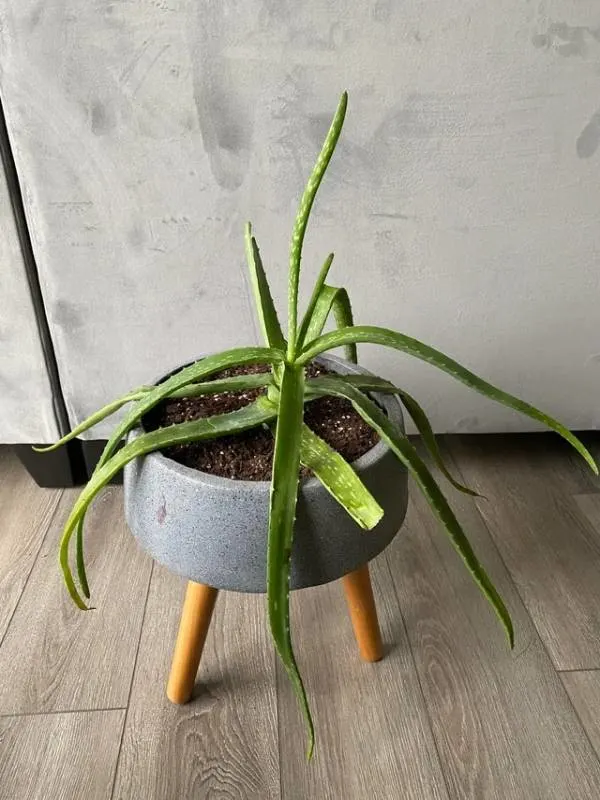
Why Do Aloe Vera Plants Droop?
They might droop because of the following reasons:
1. Large & Heavy Aloe Plants
Your aloe plant can sometimes droop under its own weight, and that’s perfectly okay!
As the aloe plants grow, healthy leaves can become heavy, causing them to bend and droop naturally.
It actually indicates that your aloe plant is happy and healthy.
However, if you notice more concerning signs like:
Change in the color of aloe leaves
Breaking aloe leaves
A soggy base, or
Signs of pesky pests on the drooping leaves (we will discuss this later in this article)
Then, it’s time to take a closer look.
In all these cases, it’s essential to inspect your aloe vera plant and its surroundings to ensure it stays in good shape.
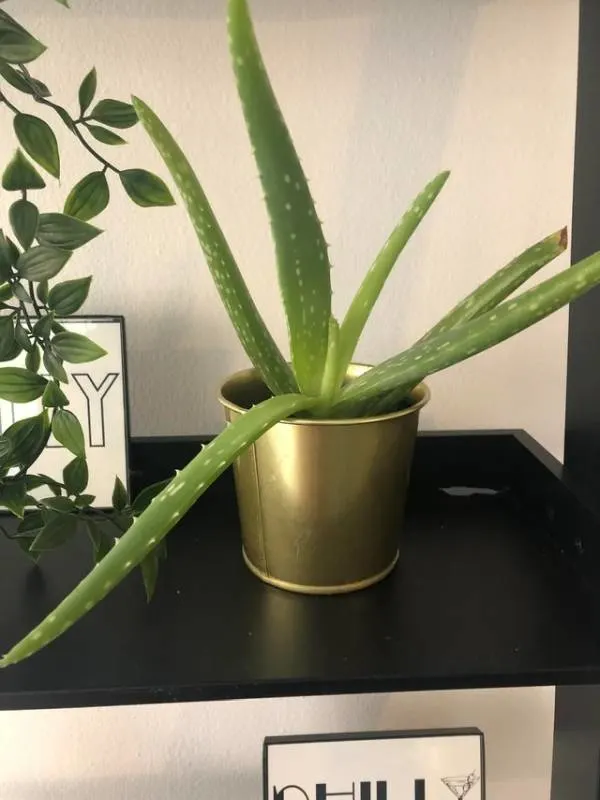
2. Temperature Shock
Aloe plants don’t like extreme weather – too hot or too cold weather can stress them out.
They feel their best when the air floats between a cozy 60 and 80 degrees Fahrenheit (15 to 26.6 degrees Celsius).
Aloe plants are like desert creatures, used to basking in warmth, so if things get too chilly, they might develop unsightly brown or black spots, and their leaves could lose their strength, leading to a drooping aloe plant.
But here’s a twist: Don’t throw them into a heatwave either!
Too much heat can cause their firm leaves to dry out, potentially leading to dehydration even at their root level.
And guess what?
Aloe vera plants are not so fond of sudden temperature changes. Going from a toasty room to a chilly one is a recipe for disaster.
Oh, and if you’re thinking of letting them soak in the outdoor environment, keep in mind they’re not frost-proof. Sunlight suits them fine, but it’s time to bring these sun lovers indoors when winter knocks at the door!
So, in a nutshell, treat your aloe plants like a temperature-sensitive friend – avoid extreme swings, give them the right amount of sunlight, and they’ll reward you with their vibrant, spiky charm.
3. Too Much or Too Little Light
Although the aloe plants are low maintenance, they have their own schedule to fulfill their light requirements.
That is why they don’t like sudden changes, especially regarding light and temperature.
Excess Lighting
These green pals need at least six hours of sunlight daily. So, put them in a room that basks in daylight to keep them happy. Otherwise, you’ll see your aloe plant drooping.
While aloe plants love the sun, direct sunlight or bright sunlight exposure can be detrimental. Therefore, make sure to provide them with just enough sunlight.
As it is said,
“Excess of everything is bad.”
Just like how we can get sunburned, aloe leaves might show brown or purple spots if they’re overexposed to direct sunlight.
Related Article: Why is My Aloe Plant Turning Brown? 7 Problems With Solutions!
But that’s only one side of the picture; let’s flip to the other.
Inadequate Lighting
If you keep your aloe plant in a spot with dim light, it’s like giving your friend a gloomy day – the energy it needs to thrive will be lacking, and you’ll end up with a droopy aloe plant.
Think of winter as a time to be extra mindful.
Just as we wrap ourselves in cozy layers, consider finding a sunny spot for your drooping aloe, perhaps near a south or east-facing window, and let it soak in that indirect, bright light.
So, keep it cool and provide that perfect balance – not under direct sun and not in complete shade – and your aloe will flourish like the sun-loving superstar it is!
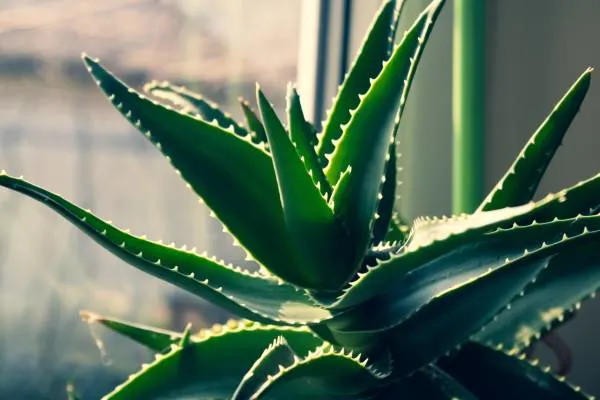
4. Too Little or Too Much Moisture
Finding the perfect watering balance for your aloe plant is crucial to its health.
Aloe plants, originally from dry environments, prefer their soil to be a bit on the dry side.
Overwatering
If you notice your aloe leaves drooping, the cause might be too much moisture.
Excess moisture can result in constantly damp soil, creating an environment ripe for fungal diseases and fungal infections that lead to root rot. The root rot makes it difficult for the plant to take in water, causing aloe’s leaves to become limp and droop.
Overwatering can also trigger soft rot in the leaves, starting at the base and extending outward.
Striking the right balance between hydration and dryness is essential because underwatering can also lead to drooping leaves in aloe plants.
Underwatering
Despite their water-storing leaves, insufficient water can cause the cells to lose internal pressure, resulting in a drooping aloe plant.
It’s important to remember that while aloe plants thrive in slightly dry conditions, they still require water to flourish.
The frequency of watering depends on factors like temperature, sunlight, and humidity.
A good guideline is to water aloe plants when the top soil surface (about two to three inches) has dried. Depending on your specific environment, this could mean watering every one to three weeks.
Maintaining this delicate balance between hydration and dryness is key to keeping your aloe plant healthy and vibrant.
Related Article: What Does An Underwatered Aloe Plant Look Like? (7 Obvious Signs)
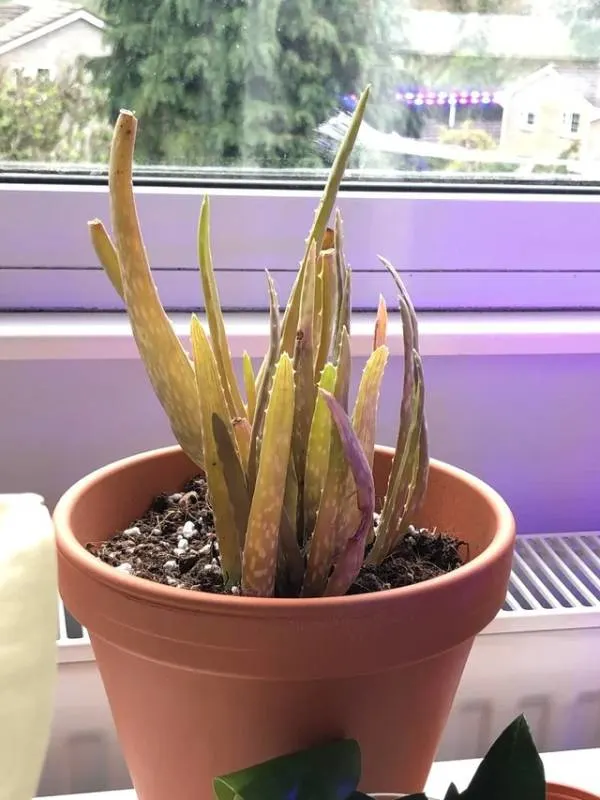
5. Poor Drainage
Poor drainage could be the cause if your aloe plant shows signs of drooping.
To keep your aloe plants healthy, remember this: Never ever drown them in excess water.
Excess water combined with poor drainage can lead to waterlogging, creating an ideal environment for fungal diseases to thrive, ultimately leading to root rot.
Drainage holes at the bottom of the plant pot play a vital role in the management of the plant’s roots.
So, when potting your aloe vera plant, choose a container with at least one drainage hole at the bottom; think of it as giving your plant a way to breathe. The more the drainage holes, the better!
Also, a fresh soil mix labeled for cacti or succulents is your best friend here. It’s important to note that it should be well draining soil, as well draining soil helps in proper drainage and allows water to move through the pot swiftly.
If you are up for a little DIY adventure, consider adding sand, perlite, or pumice into the plant potting mix – these ingredients are the superheroes of drainage.
And when it comes to pot selection, don’t go too big; aloe plant likes to stay in just the right-sized containers.
That’s the key to keeping your aloe plant thriving, whether it’s chilling indoors or basking in the sun outside.
6. Transplant Shock
Sometimes, when you move your aloe plant to a new pot, it can suffer transplant stress, just like when you feel a bit tired after moving to a new home.
It is called transplant shock.
It happens because the plant’s roots get disturbed during the move, so the plant directs energy into growing strong roots in the new soil rather than keeping its leaves healthy.
Some of the aloe vera plants don’t show any signs of shock at all, while others might look sad with droopy leaves.
To help your aloe vera cope with the move, remember two important things,
Your plant isn’t overheated
It doesn’t get dry
And timing also matters a lot!
The best times to transplant your aloe are in the morning or late afternoon when the plant isn’t thirsty.
Hot sun can dehydrate the plant, and the best way to avoid transplant stress is to make sure that the plant remains hydrated.
So, after moving your aloe plant to its new home, keep it in a shady, cool spot for a while to help it adjust comfortably to its new pot and prevent those droopy leaves.
7. Root Bound Aloe Vera Plant
Ever noticed your plants looking a bit down?
Droopy leaves might indicate some serious root business going on underground.
When plants grow fast, their root system gets cramped in the pot. It’s like trying to fit into your favorite jeans after a big meal – not very comfy!
It happens because roots can fill the pot and start cooping around each other, looking for more room.
One way to check if your plant is feeling crowded is by tipping it out of its pot and taking a quick look at the roots.
If they’re all huddled up and looking ready to bust out, it’s time for a new home.
Don’t worry, though. Giving them a bit more space isn’t too hard.
Gently loosen the soil around the roots and spread them out when you move them to a slightly bigger pot.
Just like when we need some extra space to stretch our legs, plants also need to make themselves comfortable.
But don’t go overboard – a pot just 1 or 2 inches larger than the old one will do the trick. Going too big too soon can cause problems, like unwelcome visitors (common aloe plant pests) and soggy soil.
So remember, a little room to grow goes a long way in keeping those leaves happy and perky!
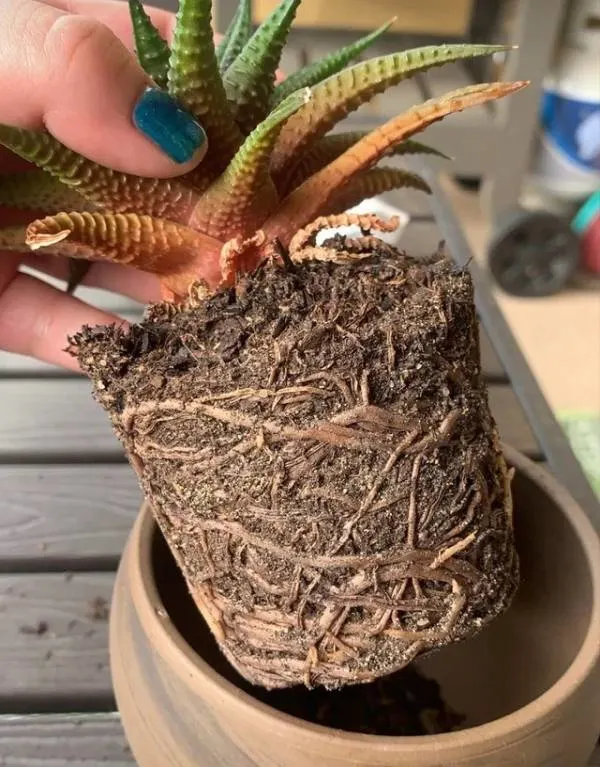
8. Pests and Diseases
While aloe plants have strong leaves, they can still be bothered by annoying pests.
Some pests are harmless, but others can harm your plants, causing various levels of damage, including drooping of leaves.
To identify if your plant is dealing with pest problems or other diseases, watch out for these signs:
Discoloration
Texture changes
Webbing
Bites and holes
Related Article: Why Does My Aloe Vera Plant Have White Spots? 5 Things To Watch Out For
If you suspect any signs of pests or other diseases, dealing with the problems outdoors is a good idea to keep them away from your indoor space.
For a natural and DIY bug remedy, you can blend:
Filtered water, and
Mild castile soap
While neem oil can be a powerful solution, it’s essential to be cautious, especially with delicate plants.
Apply it carefully, mixed with water, to avoid harming your plant unintentionally.
Make sure to follow the instructions closely, as using too much neem oil can stress your plant even more.
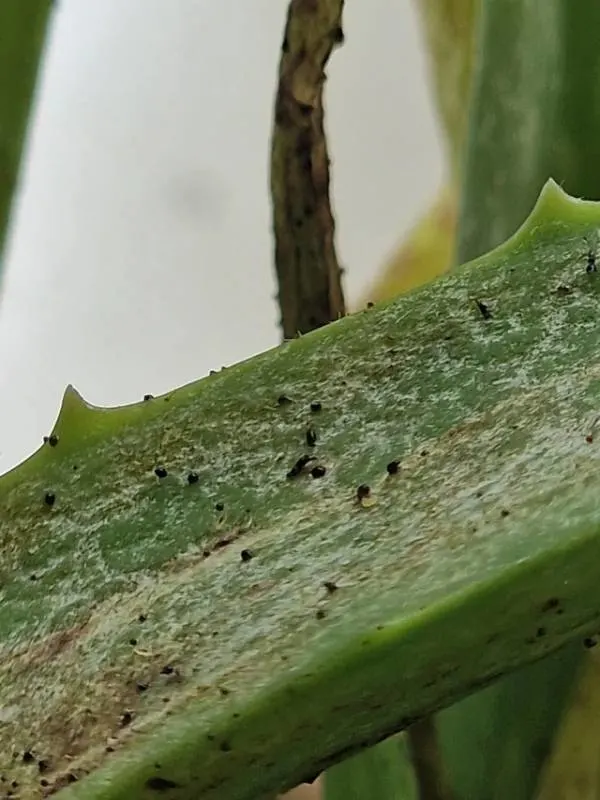
That’s all for today!
Let’s take the next step and move toward the conclusion together.
Conclusion!
Why is my aloe plant drooping, you say? I hope you now have the answer to your question.
There are many reasons behind a drooping aloe plant.
Your aloe plant might be drooping because of its natural weight. If that’s the case, you don’t need to worry. It might be due to temperature shock or inappropriate sunlight, in which case you’ll need to change the location of your plant. Improper watering can also lead to the drooping of leaves in aloe plants. Overwatering and lack of proper drainage can cause root rot in your plant, leading to a drooping aloe plant. Apart from that, if your plant is growing in a small pot, it leads to poor drainage and root bound, which can ultimately become the reason for the drooping leaves of your aloe plant.
With all that said, we’ve reached the end of our conversation.
Now, the stage is set for you to nurture your aloe plant with confidence and success.
Warmly,
Moiz Atiq.
